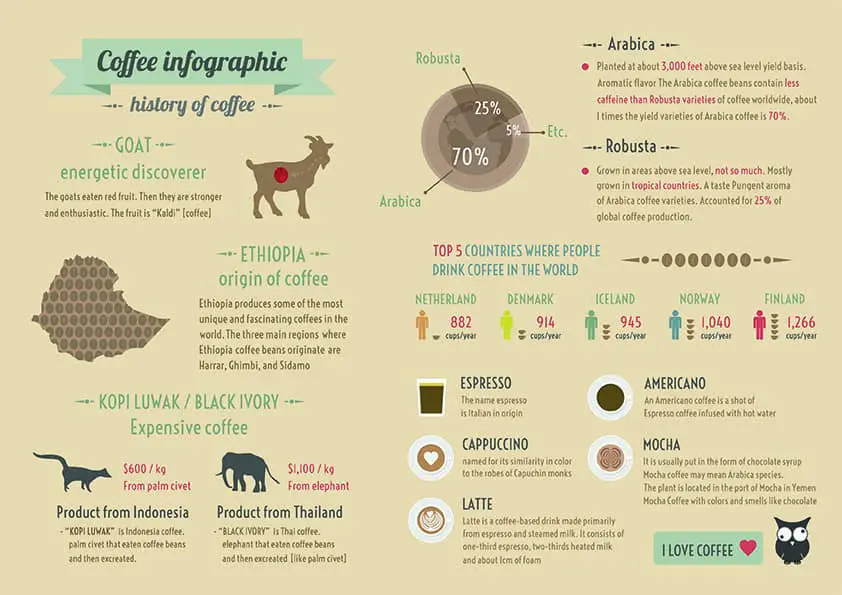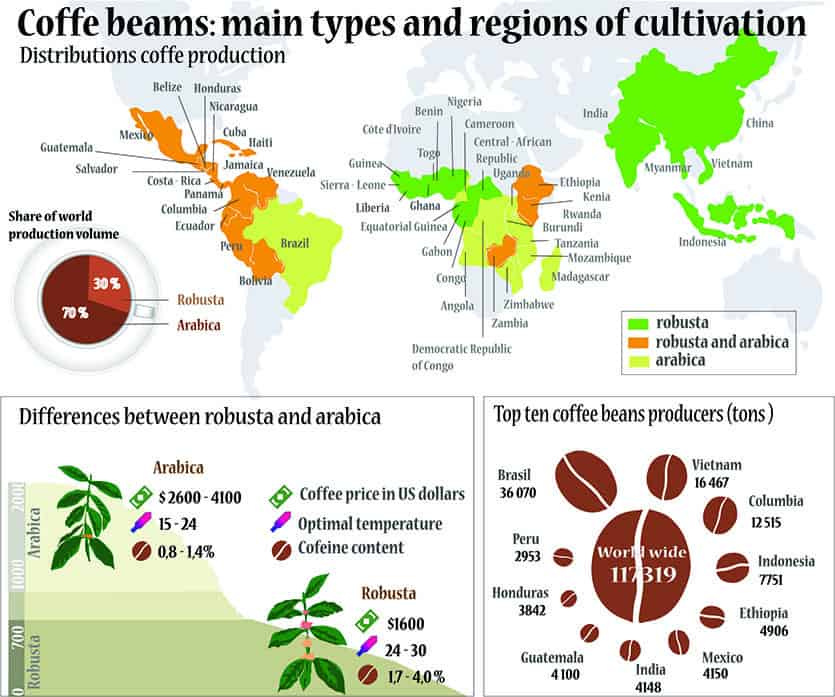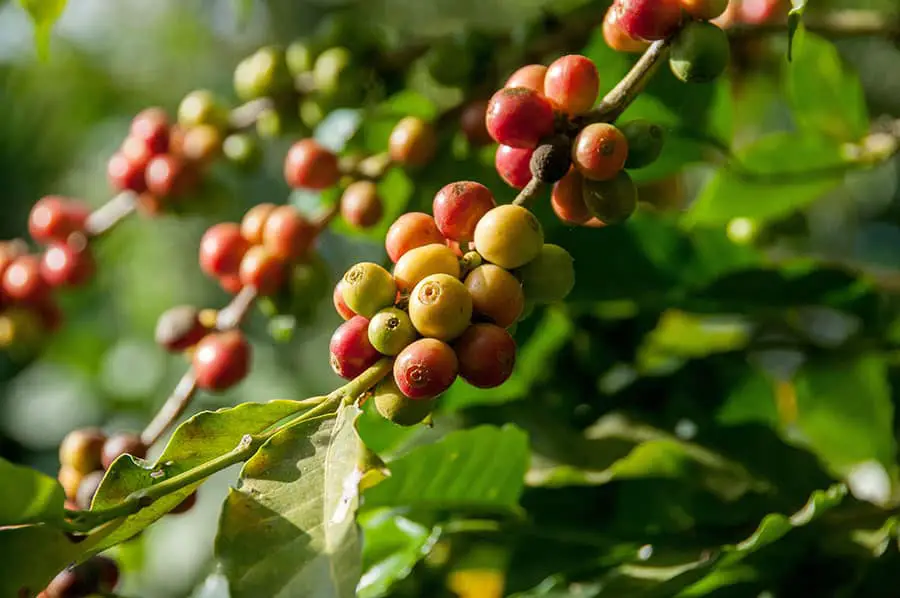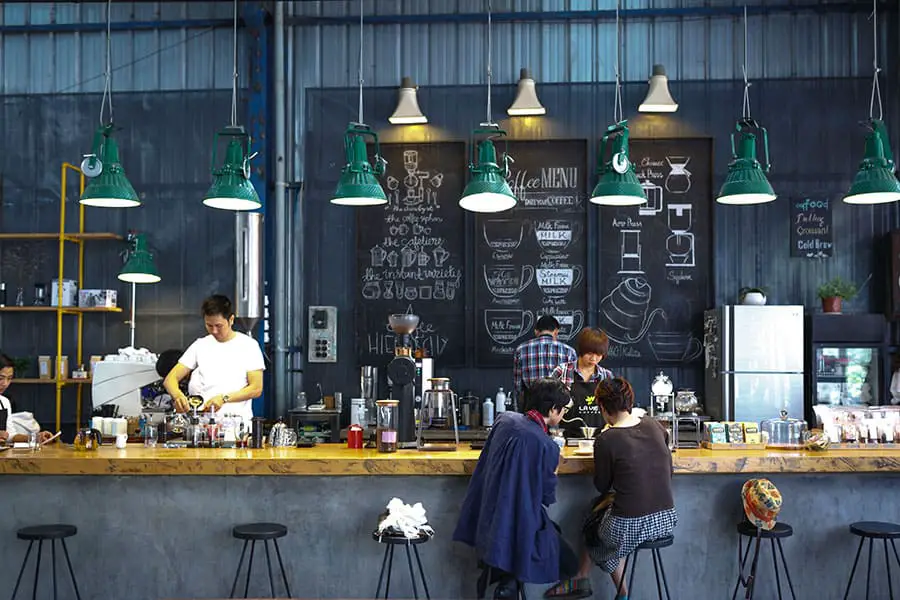
What is the history of coffee? How and when did we start drinking this liquid gold? Today, Coffee is considered by many to be the essential fuel for a good and productive day.
The history of coffee begins with a goat herder named Kaldi in Ethiopia and ends with coffee being spread around the world to become one of the most consumed drinks in the world.
But coffee itself has been through a few trials and tribulations since its magical energy giving properties were discovered centuries ago.
How did we come to turn a small, bright red coffee cherry into a drink consumed over 2 billion times everyday? Here we’re going to follow coffee on its journey, from its humble, yet still mythical, beginnings in Ethiopia to how it became a beverage of the world, grown in over 70 countries, and drunk in every single country on the planet.
The Beginning of Coffee
According to legend and this is the most commonly cited story of coffee’s origin, the energizing effects of the coffee bean were first noticed by a goat herder called Kaldi, who lived on the Ethiopian plateau way back during the 9th century.
One day Kaldi noticed that after some of his heard had grazed on the bright red cherry of the coffee plant they seemed to possess boundless energy, certainly more than the rest of his animals. As the story goes, this left them too energized to fall asleep at night, as their bundles of energy had them bounding all over the place.
From here, Kaldi tried the beans himself and found that they really were very invigorating. He chose to share his new discovery with the local monastery, who disregarded his anecdotes and threw the beans in the fire. A delectable aroma quickly began rising from the fire, and the beans were scrapped out for further investigation.
The monks then chose to crush the beans and add them to water. To their surprise, and joy, they found that the beverage gave them the same energy and vigor that it gave Kaldi and his goats, allowing them to stay awake and alert for evening mass. These monks passed their findings on to other monks and monasteries and so began the journey of coffee!
The earliest copy we have of any text containing this story comes from 1671 -seven hundred years after the fact- and that’s why it’s often cited as legend or myth. But it’s a beginning all the same!

It is important to state that there are other stories of the origin of coffee and all of them, like the above, take place on the Ethiopian plateau. Modern technology and advancements in genealogy have allowed us to trace the origins of the coffee plant back to Africa, and it is most likely, although not certain, that coffee originated from Ethiopia, and this is a, mostly undisputed, general consensus.
No one is certain at which point people started roasting and brewing coffee beans like we do today; although the story above states it, such a quick journey from coffee cherry to roasted cup of coffee is deemed pretty unlikely.
Either way, the drink of coffee began spreading across the Arabian peninsula and the Muslim world, with Yemen usually believed to being coffees first destination after leaving Ethiopia. By the end of the 16th century it was spread through the rest of the Middle East, Persia, and Turkey.
The Arabs kept a monopoly on coffee production by either boiling, roasting, or baking the beans before they left the region in order to ensure that they would not germinate if planted. So how did coffee, now planted in over 70 countries, escape the monopoly held upon it by the Arabs?
The Expansion of Coffee From Africa
The first green or unroasted coffee beans to be smuggled away from their homeland, and the monopoly held on them by the Arabs, were smuggled out by a man called Sufi Baba Budan.
He is revered by both the Muslim and Hindu traditions for this singular act of smugglary ( I think that is a word), and is often depicted with seven green coffee beans strapped to his chest; although some accounts of the story tell us that he hid them in his beard.
Sufi took these beans and planted them in his native India, in Mysore to be precise. It is from here that coffee is said to have spread to Europe before being taken by colonizers to their colonies and spread further afield.
The Origin of The Word: Coffee
We’ve discussed the origins of coffee but where did the English language word coffee originate? The word coffee has its own variant in most languages around the world, and these are almost all along the lines of coffee or cafe, and all sound very similar to how we pronounce them in English.
The English version arose from the Dutch koffie, which, in turn, came from the Turkish kahve, whilst the Turkish word was born from the Arabic qahwah. All these words have been Romanized but you can see how our term coffee, and its translations around the world, evolved along the linage noted above.
But why, coffee? Or, we might be better asking, why qahwah? This Arabic term originally defined a wine, specifically a wine which was an appetite suppressant; much like coffee is. This is the most widely accepted version as to why qahwah came to mean the drink that was produced from roasted and ground coffee beans.
The Original Coffee Drinkers
The first evidence that we have of people drinking coffee is through the practices of the residences of the Sufi monasteries -Sufi is defined as “Islamic mysticism”- to help keep them awake for evening mass. From here coffee spread towards Mecca, although its use was not limited to monasteries.
Coffee houses began popping up in the region, and they were places where men would meet to drink coffee, discuss the issues of the day, and smoke hookah. Coffee was also served in homes as a ceremonial act of kindness and hospitality, welcoming someone else into ones home.
As coffee made its way over to Europe it began life, as every new foreign import did, as a luxury item exclusively for the rich and noble people on the continent.
However, coffee spread quickly throughout society and public coffee houses emerged in many cities after a trade of coffee had been established. In these coffee houses, especially in Europe, anyone could come in a get a cup of coffee, so long as they could afford it.
We’re getting a step ahead of ourselves here though, so before we begin to discuss the effects the coffeehouse had on society lets check out how coffee actually arrived in Europe, and how the Europeans spread it to the rest of the world.
The Rise in the Popularity of Coffee
From Ethiopia and the Arabian peninsula coffee spread to northern Africa, Turkey and from there it made its way to Europe, its first port of call being Venice; a port which conducted a huge amount of trade with North Africa and the Middle East.
Merchants arriving there brought it to the wealthy Venetians, and they enjoyed it. From here, as imports increased, prices fell and availability grew.
Coffee was first judged as a “Muslim drink” and the Christians of Italy often warned against consuming it. However, it was widely welcomed into society once it was tasted and deemed a “Christian beverage” by Pope Clement VII; before this there were many petitions in Italy to outright ban coffee.
It is worth noting here that back in the early 1500’s -about 100 years before coffee reached European shores- coffee was banned on two occasions across the Arabian peninsula because of its stimulating effects.
Although coffee expanded and worked its way into the wealthiest houses in Europe it wouldn’t take off as a worldwide beverage until the Europeans first began exporting it from their colonies in India to their home countries.
Large Scale Coffee Exportation

Having colonized large parts of India the Dutch, followed by the British, began importing large quantities of coffee back to their homeland. Prior to this, countries on the Arabian peninsula had pretty much had a monopoly on the coffee trade and charged very high prices for their product.
The new imports now arriving in northern Europe helped lower prices and increase the availability of this exotic drink.
Once supply had increased and more wealthy Europeans and their monarchs had gotten a taste of this beautifully stimulating beverage, demand increased and the search for the coffee tree began.
The Dutch won the race for the coffee tree and in the early 1600’s they had some growing in the Amsterdam Botanical Gardens. By the mid 1600’s the trees were thriving and some were taken out to be planted in their colonies in southern India and Ceylon, today’s Sri Lanka.
These sights were soon abandoned and the Dutch moved their plantations to their outposts in Indonesia and Suriname, and within a few years these colonies were the major supplier of coffee to Europe.
The Dutch, being the sole possessors of the coffee tree in Europe, gave a clipping from one of their bushes to the French King as a gift when signing a treaty.
A while later, a Frenchman Gabriel de Clieu convinced the gardener of the King’s garden to give him a clipping of this plant, which he transported over to a French territory in the Caribbean. In Gabriel’s own words we find an account which tells us that water was rationed for a period of this trip and he shared his portion with his precious cargo.
He also tells how he had to thwart at least one attempt to sabotage the plant. The coffee tree thrived in the Caribbean, so much so that It is from this clipping that most of the coffee plants found in South America, Central America, and Mexico originate.
Coffee and The Americas
Coffee has had a huge effect on the countries of the Americas and, to this day, is considered one of the most important crops in the region. It is also that, worldwide, roughly 600 million people rely on the coffee industry for their survival; that’s around 10% of the worlds population. But we digress.
The production of coffee in the Americas relied heavily upon the work of African slaves and conquered native peoples. It is this use of slave labor that is attributed to France’s success in the Caribbean and coffee’s abundance through the whole tropical region of the Americas.
Brazil is now the world’s top coffee producing country, by a substantial margin. However coffee wasn’t planted in Brazil until the early 1700’s, and, although a popular plant, it really didn’t gain traction until after Brazil achieved its independence in the early 1800.
Then, the new rulers of Brazil cleared huge swaths of land for the cultivation of coffee. It is because of this that, by 1852, Brazil became the largest producer of coffee in the world. A title it has held since then.
In 1774, and resulting from the events of the Boston Tea Party in 1773, John Adams, one of the founding fathers of the USA, said that tea should be “universally renounced” and many Americans turned to drinking coffee, agreeing that drinking tea was now very unpatriotic.
Coffee and The Rest of The World
Coffee was introduced to large parts of Asia by the Dutch and they led exportation and cultivation there in India, Indonesia and Japan. Notably, it was a Spanish Monk who took coffee to to the Philippines where coffee cultivation and exportation thrived until a bout of coffee rust, coupled with an insect infestation, destroyed many of its its crops in the late 1880’s.
Following this huge dip production Philippine coffee business was gobbled up by the coffee giant that is Brazil.
Coffee might have began its story in Ethiopia but it has never really taken off in the region. True, coffee now accounts for around 25% of total exports, but before the last century it was not widely cultivated in the original home of the world’s third most popular beverage.
Coffee and The Coffeehouse

As mentioned before coffee and the popularity of the coffeehouse spread across Europe, as supply followed suit. Both coffee and coffee shop culture began in the Middle East, and it seems that wherever coffee was drunk -but not where it was cultivated- coffeehouses quickly followed in its wake.
These coffee houses began to play an important role in society and were not only places to go to drink coffee but also places where people could go to socialize, discuss the news of the day, watch live music, and play games.
Across Europe and the Middle East coffeehouses gained nicknames, such as “penny universities” in England -where it was said one could get educated for the value of a penny, which equaled the price of a cup of coffee- or in the Middle East where they were referred to as “schools of the wise”.
During the enlightenment period of the late 1600’s coffeehouses were the epicenters of, advancements in science, and changing thought in England and France, allowing people a free meeting place to discuss and organize their progressive thoughts and ideas.
The change in religious sentiment and the modern ideals coming out of the meetings taking place in coffee houses during this period were so disruptive to the general norm and way of thinking that King Charles II of England made an attempt to shutter them in 1675; this, thankfully, failed.
Coffeehouses are a relatively new phenomena across the United States, not having become mainstream meeting places until around 60 years ago. Their popularity was increased by some musicians but mainly by churches and groups as informal locations where they could hold meetings.
Coffee and Today’s World
Since coffee’s inception as a beverage coffeehouses have existed and they have provide people, of all classes and levels of education. A space to comfortably meet and hangout in, where everyone was on a level footing, and where there was none of the unruly nature found in bars and pubs; alcohol was actually banned to prevent such troubles.
Even today coffeehouses, around the world, are seen as comfortable settings for first dates, meeting friends you haven’t seen in a long time, working, and studying.
Whereas people used to work with each other in coffeehouses they now use the internet to work with other around the globe; maybe in coffeehouses also.
Coffee is considered a breakfast drink and this is because of it’s well known stimulating properties. Many claim that they “are not awake” until they’ve had their cup of morning coffee.
Coffee can be found and drunk in all the far corners of the world, on boats, on planes, and even in space. Coffee is constantly battling beer for the place of “the world’s third popular beverage” with both of these lining up behind water and tea.
Coffee’s story began in Ethiopia, and its growth is tightly woven with the expansion of Europe’s colonial powers. Having survived bans, oppression’s, a trip in a beard, and a water rationed transatlantic trip coffee is now one of the worlds biggest exports, and around 10% of the worlds population can count themselves as part of the worldwide coffee industry.
All from some cherries that energized some goats on the Ethiopian plateau over 1100 years ago.

